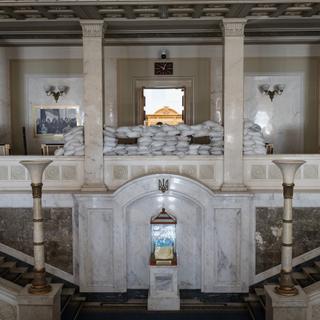


Ukraine's war-torn parliament: A symbol of resistance that's become 'a very depressing place'
FeatureUnder martial law, there are no elections in sight in Ukraine. Exhausted, lawmakers, whose mandates have expired, must remain in office until the end of the war. Many want to resign.
At first, all that can be seen from the Ukrainian Parliament, guarded by a checkpoint, are the neoclassical columns of the facade, redecorated in the Ukrainian colors of yellow and blue. Access to the chamber itself, an ultra-sensitive area of Kyiv, is even more restricted. Le Monde was granted exceptional access. After passing through a series of gates and staircases, you enter under high windows protected by sandbags, then along a marble railing, also fortified, in front of which two paintings of the Madonna and Child are displayed. Heavy engraved doors then open onto a room of ancient woodwork, bristling with Ukrainian and European flags, and topped by a spectacular glass dome. It was here, in the heart of the Rada, the Ukrainian Parliament, that MPs converged at the start of the invasion in February 2022, despite the risk of attack.
None of them have forgotten the madness of those early days, when the Russians were at the gates of the capital. "We were voting in a hurry, eyes glued to the air, fear in our stomachs, because we expected a missile to hit the glass dome at any moment," said Oleksandr Merezhko, MP for the parliamentary majority, Servant of the People, and president of the Foreign Affairs Committee. "But maintaining these sessions was crucial to show the world that Parliament was standing and that the institutions continued to function despite the war."

The Rada immediately became a symbol of resistance, but also the embodiment of Ukrainians' fight to defend their nation and the values of democracy in the face of Moscow, determined to discredit and destroy their state, whose independence Vladimir Putin has always considered an artificial creation. Contrary to public fears, the MPs did not flee en masse. The level of confidence in this institution soared to over 50%, according to several studies – an unprecedented level.
How to keep it going?
More than two and a half years later, the threat has receded since the withdrawal of Russian troops from the Kyiv region in April 2022, although enemy drones are still regularly intercepted in the vicinity of Parliament. But the war is still here, with its trail of obstacles, obligations and restrictions.
No more elections are in sight. Martial law has postponed the presidential election indefinitely. The legislative elections, originally scheduled for October 2023, have also been canceled. The absence of elections is no longer debated in the country, as many understand that with over 6 million refugees, 3.7 million displaced, 20% of territory occupied by the Russians and constant bombing, they would be neither safe nor democratic. But the challenge is unprecedented for Ukraine: How can it keep going over the long term and keep democracy alive despite the war and the impossibility of renewing its representatives?
You have 70.32% of this article left to read. The rest is for subscribers only.
